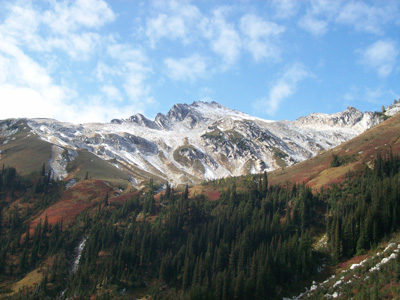Congratulations to the following 2009 Evolving Earth Student Grant recipients:
Christensen, Hilary
The University of Chicago
“The mammalian transition to herbivory in the early Cenozoic”
Terrestrial ecosystems underwent a radical transformation at the K/T boundary with the extinction of the dinosaurs in particular and all other terrestrial animal life much larger than a kilogram in general. Mammals subsequently underwent a radiation in terms of both diversity and body size. Implicit in this trend is an expansion of mammalian diets into the high-fiber herbivorous niches formerly occupied by the dinosaurs, a life habit that is possible only at large body sizes (greater than about 5 kg) due to the increased gut length required to break down plant matter. This project will examine the nature and timing of this important dietary transition and its radical transformation of terrestrial ecosystems through the early Cenozoic by analyzing the tooth microwear features of mammalian assemblages encompassing the K/T boundary, and comparing the results to estimates of body size.
Dunn, Regan
University of Washington
“Evolution of Grassland Systems throughout the Cenozoic in the John Day Basin, eastern Oregon”
The John Day Basin in eastern Oregon contains thick sections of volcaniclastic strata that were deposited from the Eocene through the Late Miocene. Preserved within these beds are rich assemblages of plant fossils that document forested conditions during the middle Eocene, the earliest Oligocene and the middle Miocene. However, a megafloral record of grasses is not preserved in these sequences. New methods for isolating and studying plant silica (phytoliths) from paleosols has allowed for a more complete picture of grassland evolution. Volcaniclastic strata of non-leaf bearing units in the John Day area are known to produce well preserved phytoliths of both dicots and grasses. I propose to collect samples for phytolith analysis from climatically important intervals during the Cenozoic, such as the Mid-Miocene Climatic Optimum to better understand how climate change influences vegetation, especially grassland habitats.
Herrera, Fabiany
University of Florida
“New Fossil Collections from the Paleocene of Colombia: Implications for the Paleoclimate and the Evolution of the Rainforests”
Neotropical Rainforest is noted for extraordinary diversity, family composition and climate, but the origins of this biome are mysterious because of a poor fossil record from the tropics. I have identified two paleofloras from the Paleocene of Colombia that are the oldest evidences of a Neotropical rainforest. Those paleofloras offer a deep-time perspective for the understanding of the evolution and paleoclimate of ancient rainforests in South America.
Leckey, Erin
University of Colorado Boulder
“The Evolution of Neogene Plant-Insect Interactions: Does Climate Drive Herbivory”
The objective of this study is to understand the role of climate on the interaction between insects and their host plants. Specifically, I plan to test the hypothesis that increasing temperature and precipitation lead to an increase in the types and levels of herbivorous insect damage. In this study, I use fossil Fagaceae assemblages and the feeding damage left by their insect herbivores to explore how specialist and generalist herbivory has changed through time and across a backdrop of changing climates.
Lynch, Eric
Bucknell University
“Comparative Scanning Electron Microscopy and Mass Spectrometry analyses of modern bacterial biofilm and soft-tissue structures isolated from Upper Cretaceous dinosaur fossils.”
Comparative Scanning Electron Microscopy and Mass Spectrometry analyses of soft-tissue vessel structures isolated from Upper Cretaceous dinosaur fossils with pure modern biofilm to evaluate the opposing hypotheses that the vessel structures are original dinosaurian blood vessels or that they are the result of invasive bacterial biofilm creating hollow endocasts of the vessel cavities. Secondary objectives include detailed sedimentologic and taphonomic data from the bone collection sites as well as Energy Dispersive X-ray Diffraction analyses of the inorganic bone matrix to provide taphonomic and diagenetic context for the bones and associated vessel structures.
Mercurio, Emily Constantine
University of Pittsburgh
“Determining Former Ice Presence, Ice Thickness and Paleo-Environments from Volcanic Fissures Erupted Under Ice During the Last Glacial Maximum, SW Iceland”
In Iceland, volcanic centers erupted under ice represent the largest untapped database on North Atlantic Pleistocene terrestrial ice conditions. The products of ice-confined eruptions in Iceland can potentially provide evidence for ice ages and, more importantly, for ice thicknesses. My research takes place in southwest Iceland on a sub-ice erupted, fissure-fed volcanic ridge named Sveifluhals. The Sveifluhals ridge represents the onshore continuation of the undersea Mid-Atlantic Ridge and is thought to have formed during the Last Glacial Maximum. By studying the multiple-vent eruption vents of this volcano and the pillow lavas that lie at the base of the ridge, it is possible to constrain paleo-ice presence and ice thickness. My research also examines the volcanogenic origins of Lake Kleifarvatn (adjacent to Sveifluhals), and how this lake may be related to the Sveifluhals volcanic fissure system.
Sallan, Lauren
University of Chicago
“The Late Devonian Crisis and the Roots of Modern Vertebrate Diversity”
Recent vertebrate faunas are primarily characterized by ray-finned fish (Actinopterygii), tetrapods, and to a lesser extent sharks and rays (Chondrichthyes). In contrast, the Devonian vertebrate world was dominated by now rare of extinct groups, such as armored placoderms, spiny acanthodians, and finned sarcopterygians. The Hangenberg extinction event of the end-Devonian (359 mya) – associated with anoxia, extreme sea level changes, and glaciation – is coincident with a dramatic turnover of both the vertebrate biota and the environment. While many studies have examined the oceanographic aspects of the extinction, none have quantified the lasting impacts on later vertebrate morphological and ecological diversification. Using morphological, statistical, and phylogenetic analyses on the extensive fossil record of one group radiating in the post-extinction period (actinopterygians), I plan to characterize the impact and implications of the crisis and subsequent recovery, placing modern vertebrate diversity in its proper evolutionary context.
Wain, Ashley
The University of Akron
“Experimental Evolution of Multicellularity with Proteome Analysis”
The origin of multicellularity was a major transition in evolutionary history and its driving force has yet to be elucidated. Using a long term evolutionary experiment, I will evolve four species of choanoflagellates, with which metazoans are expected to have shared a common ancestor, over 800 generations. Evolution will occur in two novel environments, one hyperoxic and one hypoxic, in order to recreate environmental changes that occurred 600 million years ago when multicellularity is expected to have evolved. Changes in morphology and protein regulation will be analyzed in order to test for evolution toward metazoan trait states.

